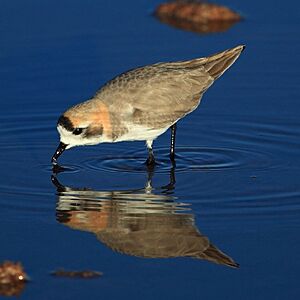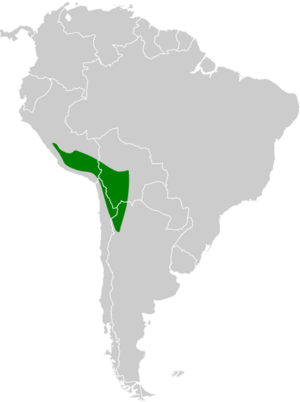Puna plover facts for kids
The Puna Plover (Anarhynchus alticola) is a small, interesting bird that lives in the high mountains of South America. You can find it in countries like Argentina, Bolivia, Chile, and Peru. This plover is part of the Charadriidae bird family, which includes many types of plovers and lapwings.
Quick facts for kids Puna plover |
|
|---|---|
 |
|
| A Puna Plover at Salar de Atacama, Antofagasta Region, Chile | |
| Conservation status | |
| Scientific classification | |
 |
Contents
What Does the Puna Plover Look Like?
The Puna Plover is a small bird, about 16.5 to 17.5 cm (6.5 to 6.9 in) long. That's about the length of a pencil! It weighs around 41 to 49 g (1.4 to 1.7 oz), which is lighter than a tennis ball.
This bird has a short, thick neck and a black beak and legs.
- Male Plovers: They have a white face with a black stripe across their forehead and another black stripe behind their eyes. These stripes connect to black patches on the sides of their chest. Their head, back of the neck, and a band across their chest are a pale reddish-brown color. Their upper body is dull brown, and their belly is white.
- Female Plovers: Females look a bit duller than males. Their chest band might be grayish, and the black parts on the male can be brownish on the female.
- Young Plovers: Baby plovers are mostly brown on top and white underneath. They don't have much of the black and reddish-brown colors that adult birds have.
Where Do Puna Plovers Live?
The Puna Plover lives high up in the Andes Mountains. You can find them from the Department of Junín in Peru, south through western Bolivia, and into northern Chile (as far as the Atacama Region). They also live in northwestern Argentina, reaching Catamarca Province.
These birds prefer the high plateaus of the puna zone. This area has short grasslands, often near both salty and fresh water lakes. They usually live at elevations between 3,000 and 4,500 m (9,800 and 14,800 ft) (about 9,800 to 14,800 feet). Sometimes, they can be seen as low as 2,400 m (7,900 ft) (7,900 feet) or as high as 5,000 m (16,000 ft) (16,400 feet).
Most Puna Plovers stay in their mountain homes all year. However, some might move to lower areas, even near the coast, during the colder winter months in the Southern Hemisphere.
Puna Plover Behavior
What Do Puna Plovers Eat?
Scientists don't know much about how Puna Plovers find their food or exactly what they eat. But we do know that their diet includes small crustaceans, which are tiny creatures like shrimp or crabs. When it's not breeding season, these birds sometimes gather in loose groups of up to 30 birds to look for food together.
Puna Plover Reproduction and Life Cycle
Puna Plovers usually lay their eggs in September and October, though this can sometimes extend to January. They lay two to four eggs on short, matted grass. We don't know how long it takes for the eggs to hatch or for the young birds to be ready to fly.
How Do Puna Plovers Communicate?
The Puna Plover isn't a very noisy bird. What is thought to be its special song for attracting a mate sounds like "pit-pit-krrrrrt..." repeated over and over. They also make a short, strong "pit" sound, which they might repeat quickly.
Is the Puna Plover in Danger?
The IUCN (International Union for Conservation of Nature) has listed the Puna Plover as a species of "Least Concern." This means they are not currently considered to be at high risk of disappearing. They live across a large area, but we don't know exactly how many there are or if their numbers are changing. So far, no immediate threats to their survival have been found. They are thought to be quite common in the middle and southern parts of their range.


